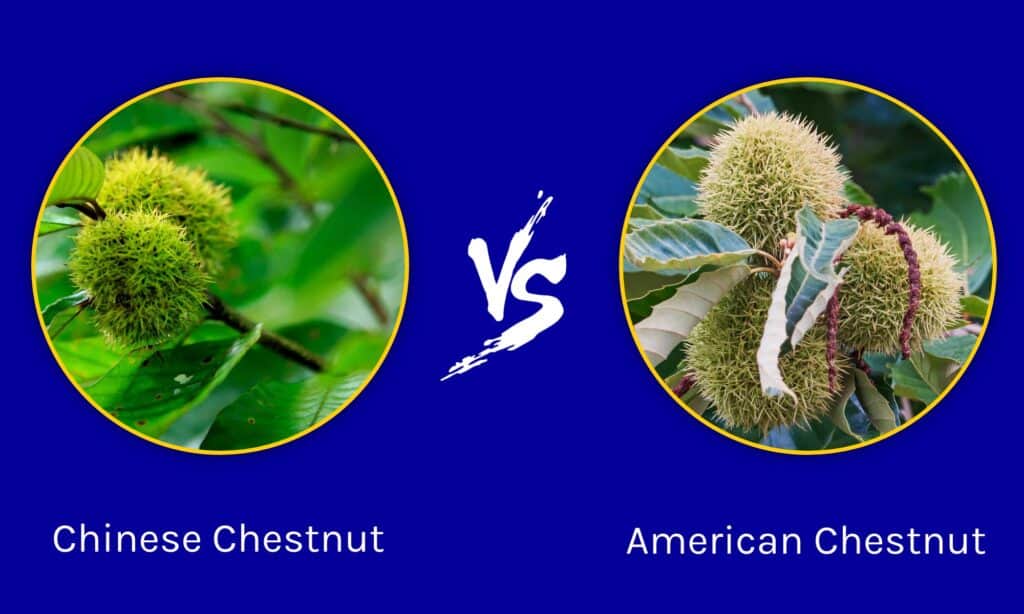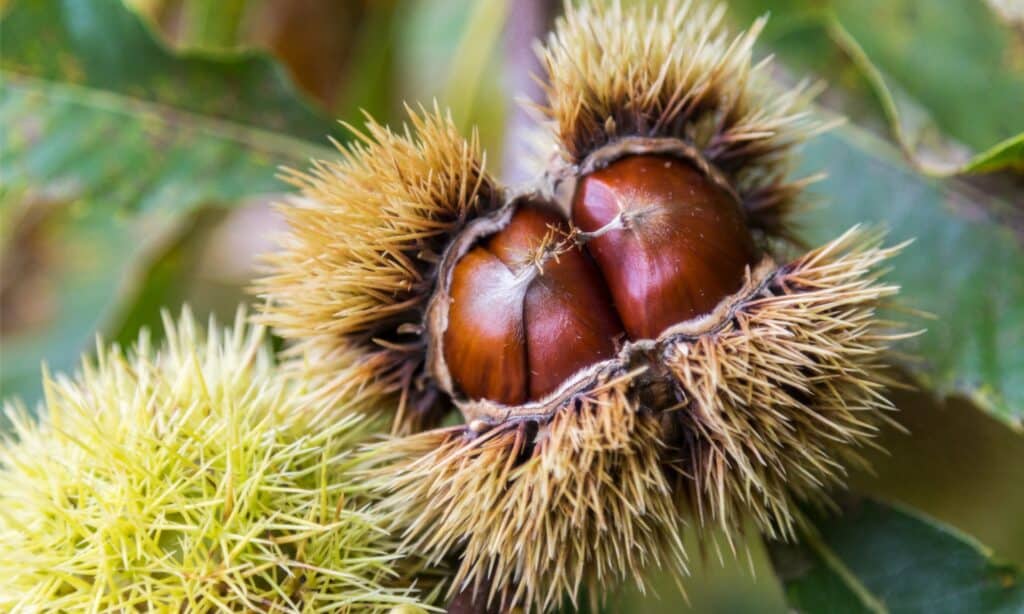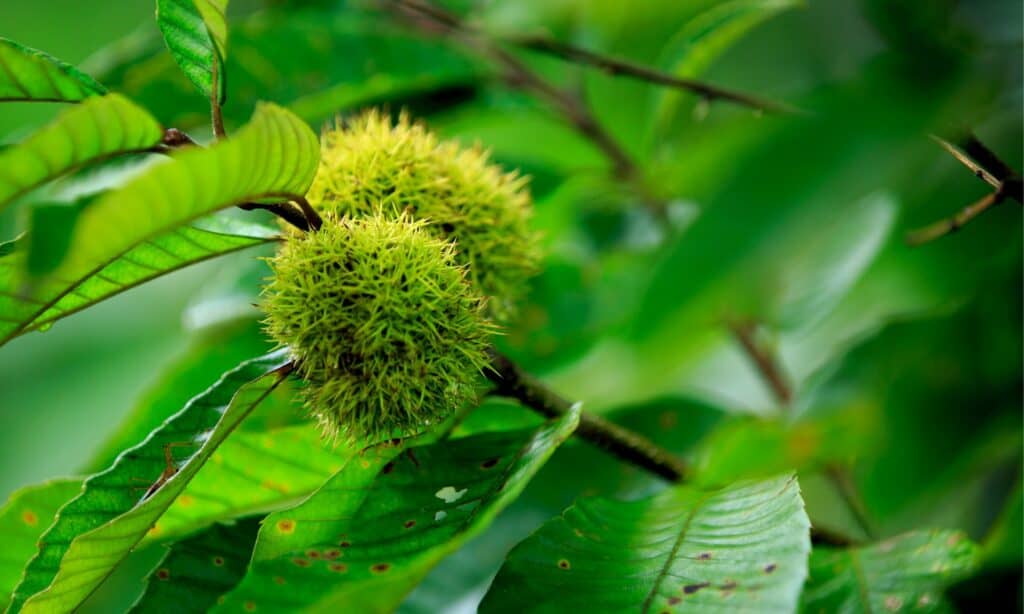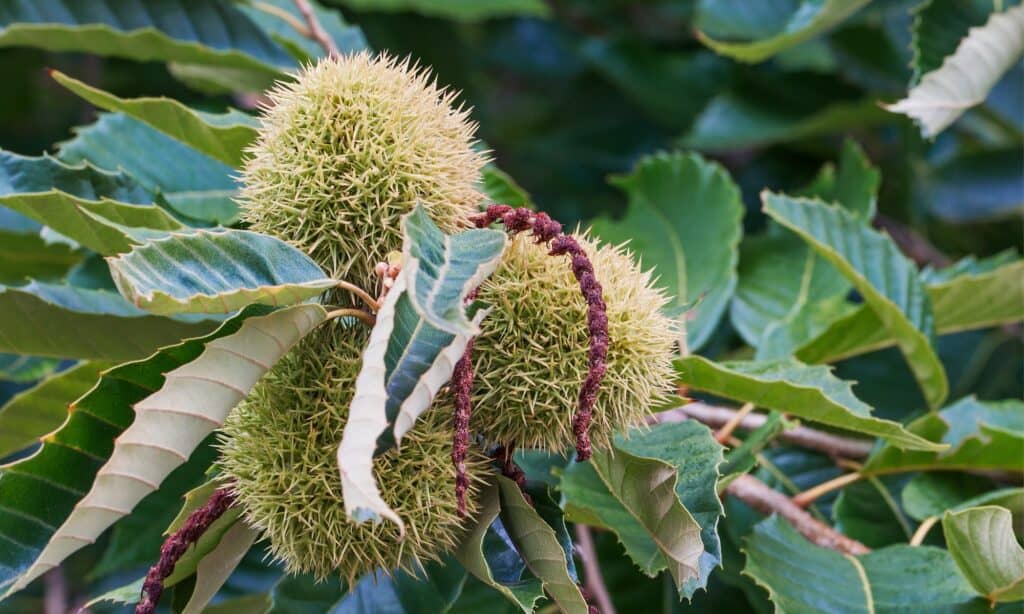Given just how many different tree varieties there are in the world, you may be wondering what the difference is between Chinese chestnut vs American chestnut. Are these trees the same besides the place they originated in, or are there things beyond that separating them from one another?
In this article, we will compare and contrast the Chinese chestnut tree and the American chestnut tree so that you can fully understand the differences between them. We will address what these trees look like as well as what they are traditionally used for. Finally, we will go over the rarity and conservation status of these two chestnut tree varieties so that you have the full picture. Let’s get started!
Comparing Chinese Chestnut vs American Chestnut

| Chinese Chestnut | American Chestnut | |
|---|---|---|
| Plant Classification | Castanea mollissima | Castanea dentata |
| Description | Reaches up to 80 feet tall. Leaves are wide and glossy, with very small teeth along the edges. Branches are slightly fuzzy, and the seed pods are covered in burrs. The pods average over an inch in diameter, and the limbs of this tree spread out more than other varieties | Reaches up to 100 feet tall. Leaves are narrow and matte, with deep veins and jagged teeth at the edges. The branches are smooth and a deep brown color. Seed pods typically less than an inch in diameter, covered in sharp burrs. Trees grow tall and distinctly upright, with narrow and tidy branches |
| Uses | Primarily used for its edible nuts, but is also one of the most resistant chestnut tree varieties to chestnut blight | Once prized for its edible nuts, but now extremely rare. Some wood can still be found in antique furniture pieces |
| Origin and Growing Preferences | Native to China and Korea; prefers acidic soil and plenty of sunshine | Native to North America, particularly the Eastern United States; prefers full sun |
| Conservation Status | Least concern | Critically endangered |
Key Differences Between Chinese Chestnut vs American Chestnut

American chestnut leaves also have distinctly toothed edges, while Chinese chestnut leaves have less obvious teeth.
©iStock.com/nickkurzenko
There are a number of key differences between the Chinese chestnut tree and the American chestnut tree. For example, the American chestnut tree grows taller than the average Chinese chestnut tree. The leaves of the Chinese chestnut tree are wider and glossier compared to the narrow, matte leaves of the American chestnut tree. Finally, the American chestnut tree is critically endangered, while the Chinese chestnut tree is classified as a plant of least concern when it comes to conservation efforts.
Let’s go over all of these differences in more detail now.
Chinese Chestnut vs American Chestnut: Classification
While they are closely related to one another and can be difficult to tell apart, Chinese chestnut trees and American chestnut trees are classified differently from one another. Both belonging to the beech family and the Castanea or chestnut genus, Chinese chestnut trees are classified as Castanea mollissima, while American chestnut trees are classified as Castanea dentata.
Chinese Chestnut vs American Chestnut: Description

American chestnut leaves are narrower and more matte in color compared to the wide and glossy leaves of the Chinese chestnut plant.
©iStock.com/yuelan
It can be difficult to tell an American chestnut tree apart from a Chinese chestnut tree, given how closely related they are. However, there are a few things you can use to identify them both as individuals. For example, the Chinese chestnut tree grows slightly shorter than the American chestnut tree overall. In addition, Chinese chestnut trees have more spreading branches compared to the narrow and upright branches of the American chestnut tree.
One of the main ways to tell these two trees apart lies in the shape and structure of their leaves. For example, American chestnut leaves are narrower and more matte in color compared to the wide and glossy leaves of the Chinese chestnut plant. American chestnut leaves also have distinctly toothed edges, while Chinese chestnut leaves have less obvious teeth. Finally, Chinese chestnut seed pods are typically larger than American chestnut seed pods, but only slightly.
Chinese Chestnut vs American Chestnut: Uses

Chinese chestnut trees are native to China and Korea, while the American chestnut tree is native to the Eastern United States.
©iStock.com/lzf
Both Chinese chestnut trees and American chestnut trees have very similar uses to each other. Both of these trees are prized for their edible nuts, and the American chestnut is credited with being roasted over an open fire. However, Chinese chestnuts are still eaten today, while American chestnuts are rarely eaten, given their overall scarcity. Once upon a time, American chestnut wood was prized for its durability, and you may be able to find some antique American chestnut furniture nowadays, something that Chinese chestnut wood is not typically used for.
Chinese Chestnut vs American Chestnut: Origin and How to Grow
The origins of the Chinese chestnut tree in the American chestnut tree are different from each other, likely something you could have already guessed. For example, Chinese chestnut trees are native to China and Korea, while the American chestnut tree is native to the Eastern United States. Both of these trees grow in a similar way, preferring full sunlight and acidic soil to thrive.
Chinese Chestnut vs American Chestnut: Conservation Status

The Chinese chestnut tree is classified as a plant of least concern, but the American chestnut tree is critically endangered.
©iStock.com/nickkurzenko
The final key difference between the Chinese chestnut tree and the American chestnut tree lies in their conservation status or rarity as a plant. The Chinese chestnut tree is classified as a plant of least concern, but the American chestnut tree is critically endangered. This is because of chestnut blight, a plague that targets chestnut trees.
American chestnut trees are particularly susceptible to chestnut blight, and this disease has nearly wiped out all of the trees in America currently. The Chinese chestnut tree is more resistant to chestnut blight compared to the American chestnut, and it is much more readily available by comparison.
The photo featured at the top of this post is © iStock.com/yuelan
Sources
- Blight Control and Restoration of the American Chestnut , Available here: https://academic.oup.com/jof/article/98/2/22/4614209
- Chinese chestnut production in the United States: practice, problems, and possible solutions, Available here: https://link.springer.com/article/10.1007/BF02858784
Thank you for reading! Have some feedback for us? Contact the AZ Animals editorial team.






